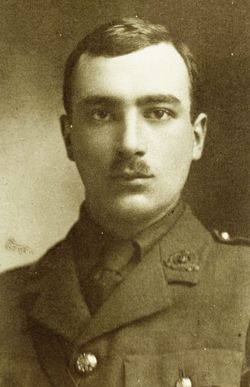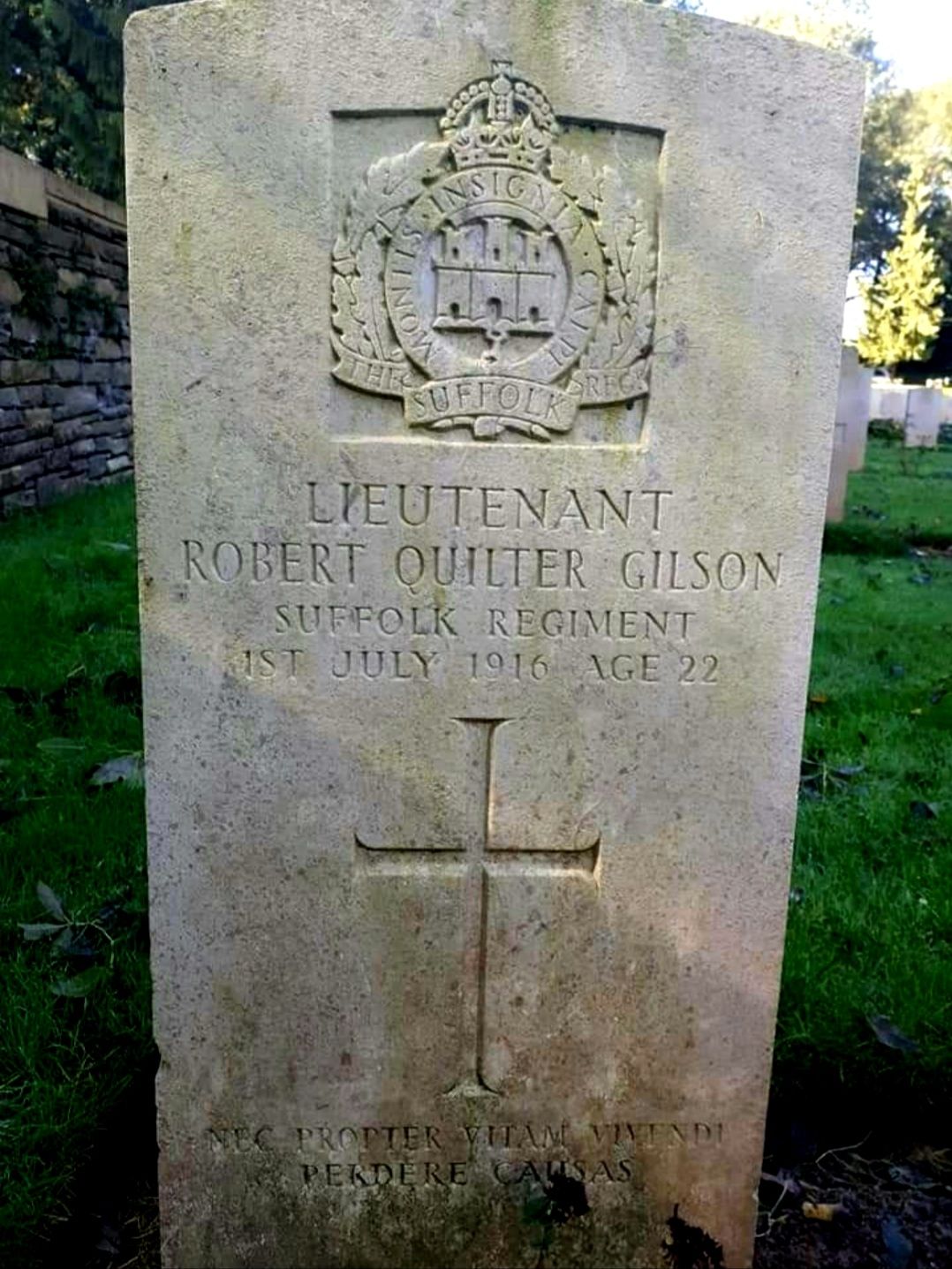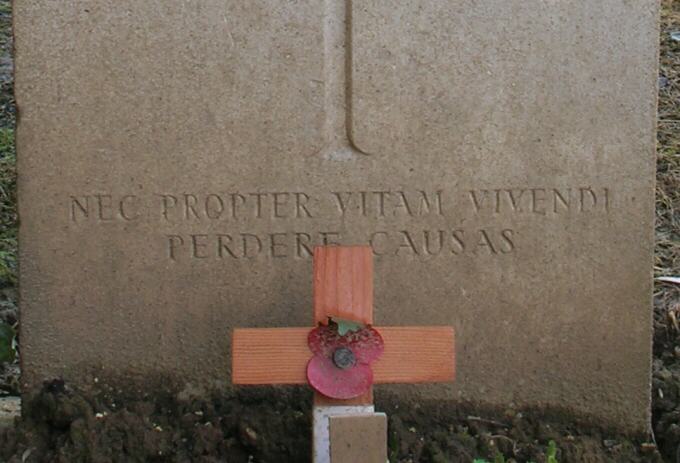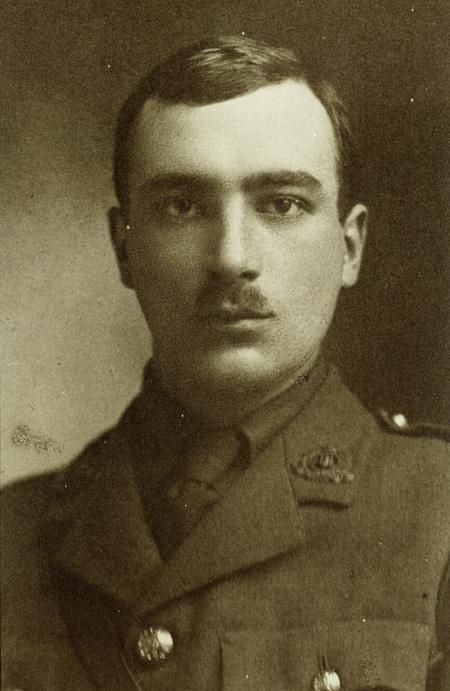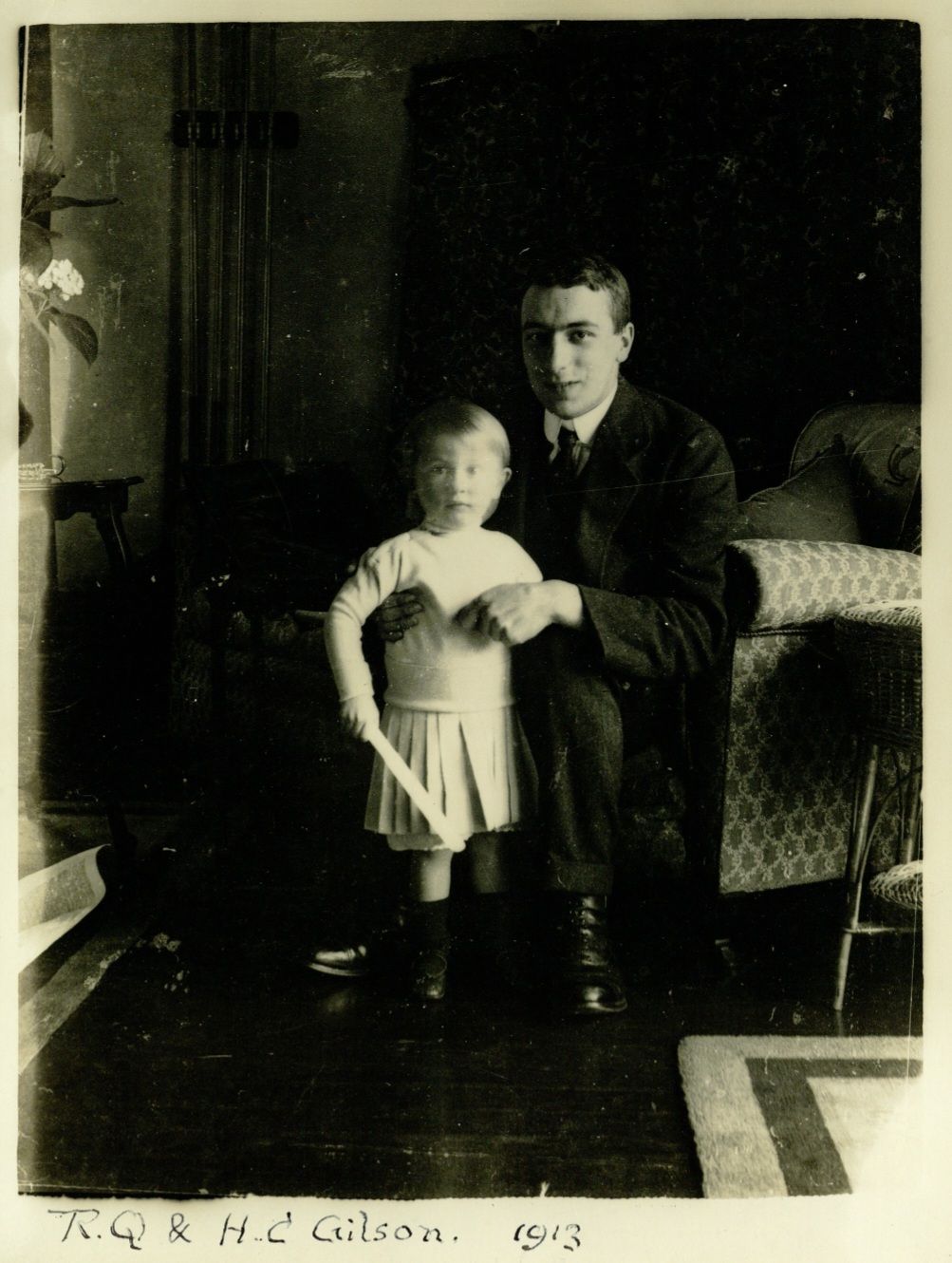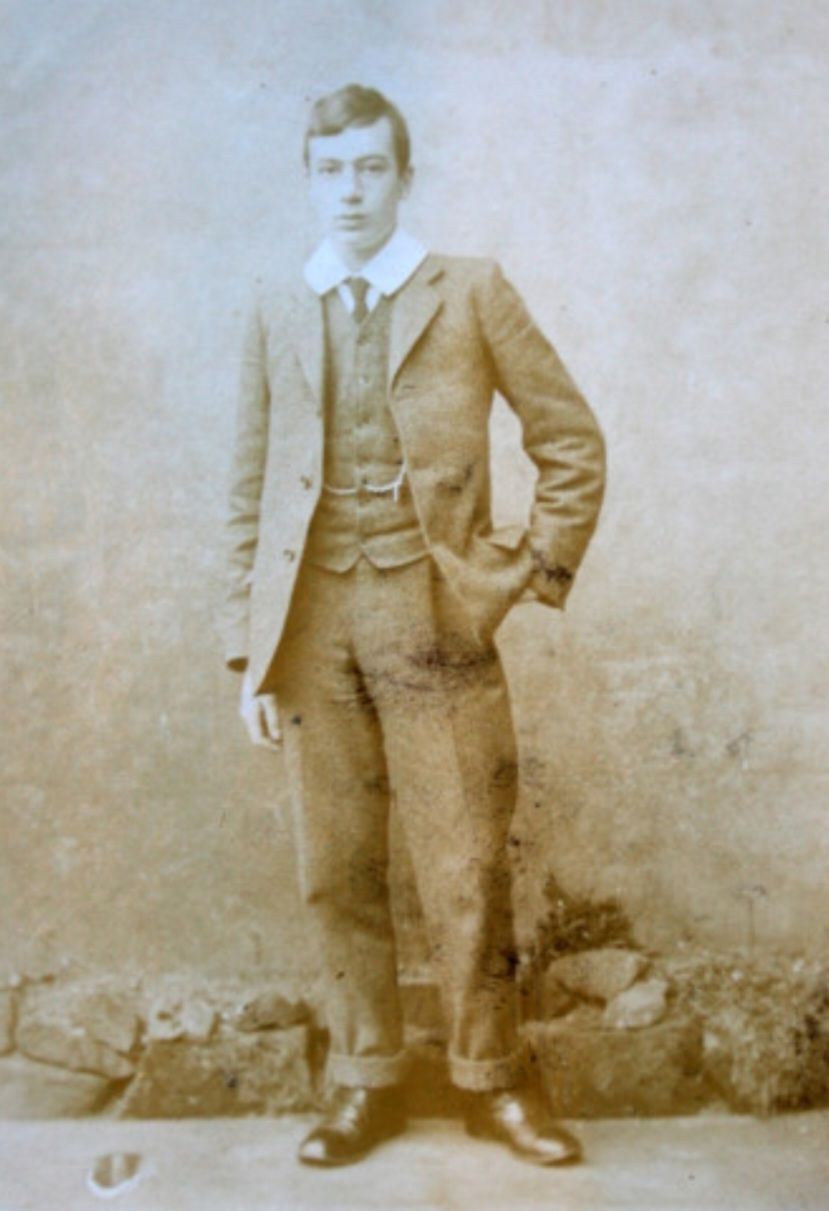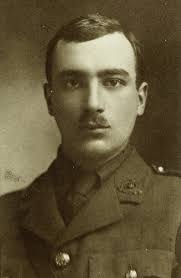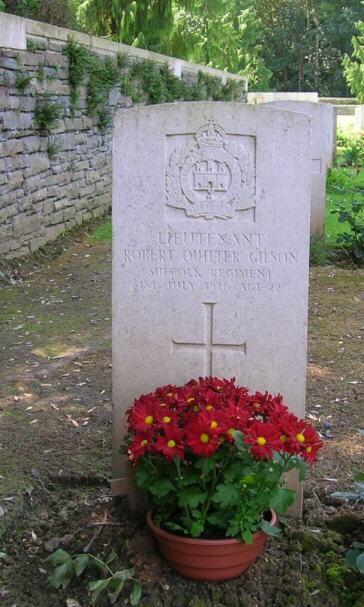Regiment: Suffolk Regiment 11th Battalion.
Died: 1st July 1916
Classical Exhibitioner of Trinity College, Cambridge.
Age: 22 years old.
Robert Quilter Gilson (known as Rob) was born on the 25th October 1893 in Harrow-on- the -Hill, and baptised on the 20th December in St Mary's Church, Harrow. He was the eldest son of Robert Cary Gilson and Emily Annie Gilson (née Newton). Rob's middle name, Quilter, was the maiden name of his paternal grandmother. Rob had an older sister, Mary Dorothea (known as Molly). His father was a Classics teacher at Harrow School. In 1900 the family moved to Canterbury House, Marston Green, near Birmingham when his father took up the post of Headmaster at King Edward's School, New Street, Birmingham. He held that post until he retired in 1929.
Rob's mother Emily died in 1907 and two years later his father re-married. His second wife was Marianne Caroline (née Dunstall). Rob and Molly called her Donna. Donna and his father had three children, Hugh, John & Caroline.
In 1906, Rob was being educated at his father's school King Edward's. He was a very good rifle shot, and was one of the shooting eight of the school's Officer Training Corps. He was also a School Prefect, Secretary of the Music & Drama Society and active member of the Debating Society.
It was here in 1911, that the Tea Club and Barrovian Society (T.C.B.S.) was formed. It was a fellowship of talented, well-educated and idealistic schoolboys who met to trade ideas during secret tea breaks, first in the school library office and then the tea rooms of Barrow's Stores. Between them they had a wide range of interests, all of which rubbed off on the others. Rob became one of the four core members along with his friends John Ronald Reuel (J.R.R.) Tolkien, Christopher Luke Wiseman, and Geoffrey Bache Smith. They all shared the conviction that they would somehow change the world through art, literature, poetry and music. The four would continue to meet even when Geoffrey and Tolkien were at college in Oxford and Christopher and Rob were at college in Cambridge.
In October 1912, Rob entered Trinity College, Cambridge to read Classics. He became a member of the Cambridge University O.T.C. A promising artist, he was fond of Renaissance painting and the 18th century. He was also a skilled draughtsman. He was passionate about architecture and he intended on qualifying as an Architect. He graduated with a First Class degree in the Classics Tripos Part I.
Rob fell in love with Estelle King, daughter of the American Consul, Wilson King. She rejected his proposals of marriage but they remained sweethearts writing to each other when Rob was later in France.
The outbreak of the Great War changed everyone's lives. Shortly after his 21st birthday, on the 28th November 1914, Rob was gazetted to the 11th Battalion, Suffolk Regiment as a Second Lieutenant.
The four T.C.B.S. friends met for the final time on the 24th/25th September 1915 in Lichfield. All four were by now in the military and undergoing training.
Rob's regiment deployed to France on the 8th January 1916. He did some excellent work in France in connection with trench construction, and was subsequently promoted to Lieutenant.
Stationed at Becourt Wood, near La Boiselle, Rob was the first of the four friends to be killed. After his Commanding Officers were killed, Rob died in a shell burst leading his men out of the trenches in the first wave of the Somme offensive, on the 1st July 1916. The German guns, which were supposed to have been destroyed by a week of heavy bombardment by British artillery, were still working. Only one of the battalion's 16 officers survived the day unhurt.
A Company Commander who was wounded wrote:
"My very last memory of the attack is the sight of Gilson in front of me and CSM Brookes on my right, both moving as if on parade, and both only a minute or two later to be mortally hit."
Albert Bradman who was Rob's Batman (an Officer's servant) wrote to Rob's stepmother on the 14th July:
"Mr Gilson was loved by all the men in the platoon and I may say Company, as he was a very good Officer and a good leader". He also wrote to Rob's father, thanking him for the "the legacy of £50 that dear Mr Gilson left me. It doesn't seem true that he can be dead, but it is quite true".
His commanding officer remembered him "advancing perfectly calmly and confidently….and (hoped) that death came quickly to him. Many times I was deeply touched by his desire to relieve me of some rather trying work, perhaps when he thought I was tired".
Rob's body was recovered and was buried in Bécourt Military Cemetery. The personal inscription on the bottom of his headstone was chosen by his father and reads " Nec propter vitam vivendi perdere causas". This Latin inscription means: "Do not for the sake of your life, lose the reason for living"
Rob was still able to see the beauty in his surroundings even in the midst of the horrors of war. In his final letter home to his father he wrote: "The devastation of war produces some unexpected beauties. I passed the other day a garden that had run wild – a riot of lovely colour. Canterbury Bells, Larkspur and Poppies growing out of the long grass".
Although he is buried in France, Rob is also commemorated in the following locations:
On War Memorials at Bickenhill and Marston Green.
King Edward's School Roll of Honour.
Trinity College, Cambridge War Memorial and Roll of Honour.
Rob's schoolboy friends, J.R.R. Tolkien and Christopher Luke Wiseman survived the war. Geoffrey Bache Smith, was a Lieutenant in the Lancashire Fusiliers. He was killed later in 1916. On the 29th November 1916, his Battalion was shelled and Geoffrey was hit by shrapnel. By the 2nd December his wounds to his right arm were considered 'worrying' and he died the following morning. He is buried in Warlincourt Halte British Cemetery.
(Sources: CWGC, Ancestry, Find My Past, Contributor: polkadot (48646929), West Bromwich History Society, Solihull Life.org, Newspaper Archives, IWM, King Edward's School, Rob Quilter Gilson Archive, Trinity College, Cambridge)
(Bio: Woose)
Regiment: Suffolk Regiment 11th Battalion.
Died: 1st July 1916
Classical Exhibitioner of Trinity College, Cambridge.
Age: 22 years old.
Robert Quilter Gilson (known as Rob) was born on the 25th October 1893 in Harrow-on- the -Hill, and baptised on the 20th December in St Mary's Church, Harrow. He was the eldest son of Robert Cary Gilson and Emily Annie Gilson (née Newton). Rob's middle name, Quilter, was the maiden name of his paternal grandmother. Rob had an older sister, Mary Dorothea (known as Molly). His father was a Classics teacher at Harrow School. In 1900 the family moved to Canterbury House, Marston Green, near Birmingham when his father took up the post of Headmaster at King Edward's School, New Street, Birmingham. He held that post until he retired in 1929.
Rob's mother Emily died in 1907 and two years later his father re-married. His second wife was Marianne Caroline (née Dunstall). Rob and Molly called her Donna. Donna and his father had three children, Hugh, John & Caroline.
In 1906, Rob was being educated at his father's school King Edward's. He was a very good rifle shot, and was one of the shooting eight of the school's Officer Training Corps. He was also a School Prefect, Secretary of the Music & Drama Society and active member of the Debating Society.
It was here in 1911, that the Tea Club and Barrovian Society (T.C.B.S.) was formed. It was a fellowship of talented, well-educated and idealistic schoolboys who met to trade ideas during secret tea breaks, first in the school library office and then the tea rooms of Barrow's Stores. Between them they had a wide range of interests, all of which rubbed off on the others. Rob became one of the four core members along with his friends John Ronald Reuel (J.R.R.) Tolkien, Christopher Luke Wiseman, and Geoffrey Bache Smith. They all shared the conviction that they would somehow change the world through art, literature, poetry and music. The four would continue to meet even when Geoffrey and Tolkien were at college in Oxford and Christopher and Rob were at college in Cambridge.
In October 1912, Rob entered Trinity College, Cambridge to read Classics. He became a member of the Cambridge University O.T.C. A promising artist, he was fond of Renaissance painting and the 18th century. He was also a skilled draughtsman. He was passionate about architecture and he intended on qualifying as an Architect. He graduated with a First Class degree in the Classics Tripos Part I.
Rob fell in love with Estelle King, daughter of the American Consul, Wilson King. She rejected his proposals of marriage but they remained sweethearts writing to each other when Rob was later in France.
The outbreak of the Great War changed everyone's lives. Shortly after his 21st birthday, on the 28th November 1914, Rob was gazetted to the 11th Battalion, Suffolk Regiment as a Second Lieutenant.
The four T.C.B.S. friends met for the final time on the 24th/25th September 1915 in Lichfield. All four were by now in the military and undergoing training.
Rob's regiment deployed to France on the 8th January 1916. He did some excellent work in France in connection with trench construction, and was subsequently promoted to Lieutenant.
Stationed at Becourt Wood, near La Boiselle, Rob was the first of the four friends to be killed. After his Commanding Officers were killed, Rob died in a shell burst leading his men out of the trenches in the first wave of the Somme offensive, on the 1st July 1916. The German guns, which were supposed to have been destroyed by a week of heavy bombardment by British artillery, were still working. Only one of the battalion's 16 officers survived the day unhurt.
A Company Commander who was wounded wrote:
"My very last memory of the attack is the sight of Gilson in front of me and CSM Brookes on my right, both moving as if on parade, and both only a minute or two later to be mortally hit."
Albert Bradman who was Rob's Batman (an Officer's servant) wrote to Rob's stepmother on the 14th July:
"Mr Gilson was loved by all the men in the platoon and I may say Company, as he was a very good Officer and a good leader". He also wrote to Rob's father, thanking him for the "the legacy of £50 that dear Mr Gilson left me. It doesn't seem true that he can be dead, but it is quite true".
His commanding officer remembered him "advancing perfectly calmly and confidently….and (hoped) that death came quickly to him. Many times I was deeply touched by his desire to relieve me of some rather trying work, perhaps when he thought I was tired".
Rob's body was recovered and was buried in Bécourt Military Cemetery. The personal inscription on the bottom of his headstone was chosen by his father and reads " Nec propter vitam vivendi perdere causas". This Latin inscription means: "Do not for the sake of your life, lose the reason for living"
Rob was still able to see the beauty in his surroundings even in the midst of the horrors of war. In his final letter home to his father he wrote: "The devastation of war produces some unexpected beauties. I passed the other day a garden that had run wild – a riot of lovely colour. Canterbury Bells, Larkspur and Poppies growing out of the long grass".
Although he is buried in France, Rob is also commemorated in the following locations:
On War Memorials at Bickenhill and Marston Green.
King Edward's School Roll of Honour.
Trinity College, Cambridge War Memorial and Roll of Honour.
Rob's schoolboy friends, J.R.R. Tolkien and Christopher Luke Wiseman survived the war. Geoffrey Bache Smith, was a Lieutenant in the Lancashire Fusiliers. He was killed later in 1916. On the 29th November 1916, his Battalion was shelled and Geoffrey was hit by shrapnel. By the 2nd December his wounds to his right arm were considered 'worrying' and he died the following morning. He is buried in Warlincourt Halte British Cemetery.
(Sources: CWGC, Ancestry, Find My Past, Contributor: polkadot (48646929), West Bromwich History Society, Solihull Life.org, Newspaper Archives, IWM, King Edward's School, Rob Quilter Gilson Archive, Trinity College, Cambridge)
(Bio: Woose)
Inscription
NEC PROPTER VITAM VIVENDI
PERDERE CAUCUS
(Do not for the sake of your life,
lose the reason for living)
